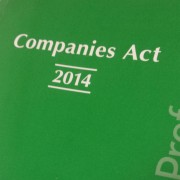Re-branding, change and Employment law
REBRANDING, CHANGE AND EMPLOYMENT LAW
When a company is contemplating a change of brand, a vital part of the change management process is engagement with employees. A change in brand, focus and company culture affects employees. They are the people who will be tasked with managing and supporting the changes that a rebranding will bring. The company will invest time and money in planning, designing and implementing the new brand. It must also focus on whether the change of brand, focus and company culture complies with employment law.
It is useful to examine two high profile re-branding exercises demonstrating the importance of employee engagement. One rebranding was a resounding success and the other a regrettable mistake. A key factor in the success and failure of each was the manner in which each enterprise engaged with its employees at the time. Two UK cases provide good examples for Irish businesses on the need to vet rebranding changes for compliance with employment law.
The Success: Arthur Anderson Consulting to Accenture[1]
Arthur Anderson Consulting was an offshoot from the Arthur Anderson accountancy firm. The consulting element of the business overtook the accountancy firm in financial terms; benefitting from a surge in popularity of consulting firms in the 1980’s. This led to a split between the two with the consulting wing paying 15% of profit to the accountancy firm. The inevitable legal battle followed; lasting for two and half years, costing millions of dollars and ultimately being resolved at arbitration in August 2000. Part of the ruling of the arbitrator was that Anderson Consulting had to change its name by December 2000 and it was released from the requirement to pay 15%.
To begin with, the views of all employees were sought on what the new name of should be. 2,677 suggestions were made by employees from 42 countries. The names were then voted on until Accenture was settled upon. Given the short time frame, the business moved quickly to phase in the new name while phasing out the Anderson Consulting brand. By New Year 2001, employees returning to work post -holiday came back to fully rebranded offices right down to their individual business cards. The CEO and the Chairman communicated directly with the employees through webcasts in each of the global offices. Managers were provided with information packs for clients and the market for immediate delivery. Arguably there was a legal imperative behind the swift efficiency – the arbitrator’s award had to be complied with. It is an impressive example of how to manage a major change beginning with a global workforce.
The Failure: Royal Mail to Consignia and back again
The origins of Royal Mail can be traced back to the 1500’s. The UK Government under Labour decided that it would liberalise the postal and communications market within the UK in 2001. This led to a decision by Royal Mail to undergo a rebranding exercise. It is understood that work was done on the name change from the self- explanatory Tudor designed Royal Mail to Consignia; without any employee engagement, any customer opinions being tested and without any advertising about the name change. The lack of engagement on the change with employees led to the unions boycotting it. The reaction was neatly summarised by John Keggie of the Communications Workers Union who said “We should be trading on the British Post Office’s worldwide reputation for honesty and integrity. I cannot see the point of inventing a new name to replace a highly respected tried and tested brand which the public hold close to their hearts. We will campaign to persuade the Post Office to change its mind.” [2]
The result of the exercise was a cost of £2 million including disposal of Consignia branded signage that didn’t comply with UK Company law requirements to begin with. Different interpretations of the new name were possible notably that it was close to Spanish for “left luggage”. The name was ultimately changed back to Royal Mail.
Employment law issues
Legally, a re-brand and a desire for corporate change or for a particular corporate image can breach employment law.
Lisboa v Realpubs Ltd & Ors UKEAT/0224/10/RN.
Charles Lisboa brought a claim against Realpubs Ltd in the following circumstances; the Coleherne Arms Public House in Earl’s Court, London developed a national and international reputation as London’s first “gay pub”. Realpubs Ltd own and operate “gastropubs” and specialise in buying failing pubs, rebranding them as gastropubs and repositioning them in the market. The Company acquired the Coleherne Arms in 2008 when its fortunes were in decline. It was refurbished and renamed; launched as the Pembroke Arms and opened for trade on the 5th December 2008.
Mr Lisboa interviewed for a role as Assistant Manager and was appointed. At his interview; he was told that the plan was to “transform it (sic the pub) from a ‘gay pub’ into a gastropub”. Evidence was given that the general manager was instructed to display a board outside the pub saying “this is not a gay pub” which Mr Lisboa amended to “under new management- friendly staff”.
An e-mail was sent to an advisor to an investment company with an interest in Realpubs stating “management are hitting the streets and making sure everyone knows about us and that we are no longer an exclusively GAY pub. We are barring ‘over the top’ old customers but this needs to be done right!!….”
The policy of Realpubs was to encourage staff to seat customers or groups of customers who did not appear to be gay in prominent places in such a way that they could be seen from outside the pub. A director visited the pub at lunchtime with his family on Sunday 14 December 2008 and deliberately positioned himself at a table within sight of the outside. On the same occasion, the Claimant stated in evidence, that the director said;”Charles is gay but another kind of gay.” The director denied making that remark but the ET accepted the Claimant’s evidence.
The gender balance amongst staff members changed. It was Realpubs policy to have a more even balance between the sexes. At the re-launch on 5 December there were 9 male members of staff: 5 female and 3 male managers. By 5 January 2009, the numbers of male and female non-managerial staff were even at 6 each. 5 male members of staff had left during that month; 2 were dismissed on grounds of unsatisfactory performance.
The Employment Appeals Tribunal had no difficulty with the idea that the new owners wished to broaden the appeal of the pub. However, it found “plainly andunarguably” that gay customers were treated less favourably on the grounds of their sexual orientation by the new owners and that Mr Lisboa was also treated less favourably on grounds of his sexual orientation. The question of remedy was remitted back to a newly constituted Employment Tribunal by the EAT.
Similarly, in the case of Dean V Abercrombie & Fitch (2203221/2008) Ms Dean was recruited to work in a flagship store in London for the company. She was born without a left forearm and had a prosthetic limb from her left elbow down. She was required to work in the stockroom and on the shop floor. While on the shop floor she wore a cardigan over her uniform polo shirt however her line manager told her to work in the stock room and that she could only work on the shop floor if she took the cardigan off in order to comply with the company “look”. The Court held that management “conspicuously failed to acknowledge that the claimant might have been justifiably upset at the peremptory way she was told to leave the shop floor, that this could have offended any sensitivity she might have felt about her disability or that any apology might have been appropriate.” An award of £7,800.00 together with £1000.00 for loss of earnings was made in favour of Ms Dean.
Employees are at the forefront of any rebranding process. The chances of success of the process are greatly improved with employee engagement from the very beginning.
As illustrated by the above UK case examples, employers in this jurisdiction must also vet the proposed changes to ensure that they do not breach employment law. For example, a new requirement for employees to project a particular physical image or lifestyle and/or dress in a particular way may be discriminatory and breach the Employment Equality Acts 1998-2015. In addition, a business that seeks to attract a new customer base or consumer market share may breach the Equal Status Acts 2000-2012 by discriminating in the way that it offers its goods and services to the public. Both the Equality Acts and the Equal Status Acts prohibit discrimination on the grounds of gender, sexual orientation, disability, civil status, age, membership of the Travelling Community, race, religious belief and family status.




